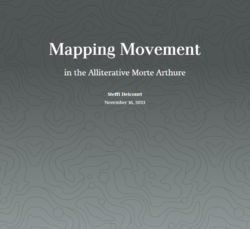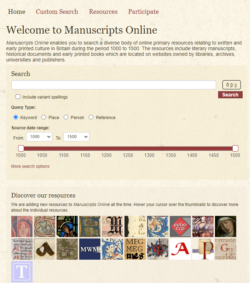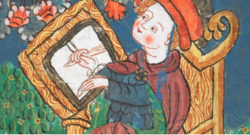METS in Use
METS editions are used in a variety of ways beyond scholarly publication, including classroom instruction, performance, and digital humanities projects such as text mining. Some examples of METS-based projects are listed below; see our Zotero library for a longer listing of current projects, including published reviews of our volumes. If your project uses METS texts and you would like to see it added here, contact our Executive Director at [email protected].

MORROIS
Mapping of Romance Realms and Other Imagined Places
MORROIS is an index of line-by-line instances of place names in Middle English romances; all explicit references to any distinct place (whether noun, adjective, or other derived form) are catalogued. While these datasets are designed to be projectable across a map, the site should also be seen as both geographic index and gazetteer, allowing users to search by romance, manuscript, language, date, and/or place to find these geographic referents. Using Omeka Classic, the team is currently working to include all place-names in both the Auchinleck Manuscript (Edinburgh, National Library of Scotland Advocates’ MS 19.2.1) and the Lincoln Thornton Manuscript (Lincoln, Lincoln Cathedral Library MS 91). The project uses the METS edition of the Alliterative Morte Arthure.

Mapping Movement in the Alliterative Morte Arthure
by Steffi Delcourt (University of Rochester)
A mapping project that visualizes places named in the Alliterative Morte Arthure, with filters for various geographic features. This map is designed to be a pedagogical tool to help readers come to a better understanding of how the terrain that is traveled through may have affected (and been reflected in) the poem’s important plot points, as well as get a sense of the extent of Arthur’s military campaign. In addition to Delcourt’s methodology and metadata, the site also includes background context for the text and a bibliography for further reading.

Gower as Data: Exploring the Application of Machine Learning to Gower’s Middle English Corpus
by Kara McShane (Ursinus College) and Alvin Grissom III (Ursinus College)
Distant reading, a digital humanities method in wide use, involves processing and analyzing a large amount of text through computer programs. In treating texts as data, these methods can highlight trends in diction, themes, and linguistic patterns that individual readers may miss or critical traditions may obscure. Though several scholars have undertaken projects using topic models and text mining on Middle English texts, the nonstandard orthography of Middle English makes this process more challenging than for our counterparts in later literature. This collaborative project uses Gower’s Confessio Amantis as a small, fixed corpus for analysis. We employ natural language processing to reexamine the Confessio’s themes, adding data analysis to the more traditional close reading strategies of Gower scholarship. We use Gower’s work as a case study both to help reduce the potential variants across textual versions and to more deeply investigate the corpus than distant reading normally allows. The project uses the METS editions of Gower’s Confessio Amantis and In Praise of Peace.

Medieval Digital Resources
by the Medieval Academy of America
The Medieval Academy of America is a scholarly community committed to advocating for the field of Medieval Studies and its practitioners, and to deepening, broadening, and sharing knowledge of the medieval past. The MAA's Medieval Digital Resources (MDR) site is a curated database of peer-reviewed digital materials for the study of the Middle Ages. The MAA highlights the Middle English Texts Series as a helpful resource and has previously selected METS for the spotlight during National History Day.

Manuscripts Online
Manuscripts Online is a database that allows users to search a wide array of digitized primary sources in Britain, written from 1000-1500 CE. The resources include literary manuscripts, historical documents, and early printed books from websites owned by libraries, archives, and universities – including the METS corpus. Clicking on search results will redirect users to the full-text content on the resource’s original website. Users can search by various types of keywords, include Middle English characters in their keyword searches, see variant spellings of their search terms, filter by various categories, make comments, and locate search terms on Google Maps if they have geographical significance.

Online Medieval Sources Bibliography
Based out of the Fordham Center for Medieval Studies, the Online Medieval Sources Bibliography is a database providing a searchable bibliography of texts written during the Middle Ages that are available in modern editions and translations – including the METS series. The majority of the texts are primary sources from England, France, and Ireland circulating between roughly 300 and 1500 CE. Users can search by author or source, and search results provide either a brief author biography or annotated entries providing information like a text’s contents, date of composition, original language, geopolitical region, genre, archival reference, and hyperlinks to full-text digitized works.

The International Hoccleve Society
The International Hoccleve Society is devoted to promoting scholarship on the late-medieval poet Thomas Hoccleve, provoking innovative research into the poet, and providing a community for Hoccleve scholars. The Society highlights Charles Blyth's METS edition of The Regiment of Princes as an openly available resource. The Society was formed at Kalamazoo 2011 and has been supported by Baylor University's English Department.

Machaut: Remede de Fortune by Voces Collegium SJSU
A 2021 performance of Guillaume de Machaut’s Remede de Fortune [Remedy for Fortune] by San Jose State University’s early music group Collegium Musicum. In Machaut’s narrative poem, an unnamed male protagonist is mentored by lady Esperance [Hope] in the ways of love. The performers use the METS text and translation of Machaut’s Remede de Fortune.

Audelay: Brian Story's "GAUDE"
Performed by Musica Spei
On November 18, 2016, the Musica Spei vocal ensemble performed the late Brian Story's "GAUDE" at the Rochester Early Music Festival, marking the piece's world premiere. Drawing on John the Blind Audelay's "Salutation to Saint Anne," as found in Susanna Fein's edition of Poems and Carols (Oxford Bodleian Library MS Douce 302), Story composed an original piece for the early music group Musica Spei's 20th anniversary. "GAUDE" is written for both vocal and bell choirs, as well as percussion. Musica Spei has graciously provided an audio recording of the performance, which now stands as a testament to the life and legacy of Brian Story.

The Premodern Performance Cultures Network
Formerly the Early English Drama and Performance Network
This project seeks to bring together researchers, students, and practitioners working on all aspects of medieval and early modern performance in the broadest possible terms. International in scope and outlook, the Network encourages cross-disciplinary, cross-period dialogue, taking in performance cultures across the entire premodern world. The Network acts as a central hub for the global community of scholars and students of premodern performance. The Network highlights METS as a resource for students, researchers, and performers studying medieval drama (such as the York Corpus Christi and N-Town play cycles).

Middle English readings from Ursinus college students
Audio recordings of Middle English texts read by Professor Kara McShane’s students at Ursinus College. The project has two goals: to support student understanding of Middle English prosody and to create classroom resources for others to use. The project uses the METS edition of Gower’s Confessio Amantis.

Chaucer Studio
The Chaucer Studio produces audio recordings of medieval and early modern texts, predominantly in Middle English. The project uses the METS editions of King Arthur’s Death and Sentimental and Humorous Romances.

METS staff reading
A video of METS’ student staff, led by the former General Editor Russell Peck, reading an excerpt from the Middle English The Floure and the Leafe, from METS’ inaugural publication (1990) edited by Derek Pearsall. It was recorded for the 2015 celebration of Whan That Aprille Day, a day intended to honor archaic and dead languages.

The Traditional Ballad Index
edited by Robert Waltz and David G. Engle
The Traditional Ballad Index is a collaborative effort to catalog traditional folk ballads. Users can search the Index's rich collection in a variety of ways, identifying various resources for study. The Index includes reference information for each ballad, often including links to METS editions where relevant.

Read Older Scots
The Read Older Scots project aims to develop a suite of resources for teaching Older Scots literature — texts, study guides, recordings, podcasts, and an interactive web app for learning to read Older Scots (eventually!) — all freely available from this website. The goal is to make it more manageable for teachers, and attractive for pupils, to study this unfamiliar material from the period when Scotland’s literary culture — and the Scots language itself — was far more autonomous and self-aware than it would become after full political union with England. This page links to all the Scottish texts in METS’ online corpus, divided into named authors and anonymous works.

Let's Read Middle English
A YouTube Series by Megan Maldonado
Megan Maldonado is Ph.D. candidate in English and Comparative Literature at Columbia University. As a researcher and university instructor, Megan utilizes YouTube to communicate with a broader audience. METS features prominently in Megan's videos, particularly in her "Medieval Masculinity" series. Alan Lupack's Three Middle English Charlemagne Romances can be spotted among the editions used by Megan.

Forgotten Ground Regained: A Poet’s Guide to Alliterative Verse
Created and developed by theoretical linguist and poet Paul D. Deane, this website is dedicated to compiling, understanding, and appreciating modern alliterative poetry. Highlights include a compilations of recently published alliterative poetry; an indexed archive of authors and texts; full-text resources for Classical, Biblical, and medieval models; a brief history of the modern alliterative revival; and an essay exploring the styles and themes of historical alliterative verse. Links to METS’ alliterative Middle English and Older Scots texts appear on this page.

“Teaching MS Harley 2253 in the High School Classroom: Four Lesson Plans – Introduction”
From Once and Future Classroom 14.2 (Spring 2018)
Susanna Fein, editor of the Complete Harley 2253 Manuscript in three volumes, introduces four lesson plans from students of her Spring 2017 graduate seminar on the said codex, many of whom were high school teachers in Northeast Ohio. Their innovative lesson plans, built around the modern English translations of Fein’s edition, are designed for a range of students from widely varying socioeconomic and ethnic backgrounds. Each of the authors describes their teaching environment, provides classroom content and resources, details a culminating project, and explains their pedagogical rationale.

“What do YOU stand for? Elements of Protest in MS Harley 2253 and Modern Culture”
by Heather Matoszia (Northwest High School, Canal Fulton, Ohio)
A lesson plan that asks high school students to make connections between political protest songs of the 1960s and modern social media with selected Harley 2253 texts expressing medieval social protest. The assignment culminates in a two-part multimodal project that includes a research paper and a creative element. Grading rubrics are included. The lesson plan highlights as resources four texts from Susanna Fein’s Complete Harley 2253 Manuscript edition: Ich herde men upo mold [Song of the Husbandman], Talent me prent de rymer e de geste fere [Trailbaston], Mundus iste totus quoddam scaccarium est [All the World’s a Chess Board], and Dieu, roy de magesté [Against the King’s Taxes].

“Teaching the Harley 2253 King Horn with a Reader’s Script”
by Charmae Cottom (Pioneer Career and Technology Center, Shelby, Ohio)
A lesson plan that uses the medieval romance King Horn to engage vocational high school students who may feel “orphaned” by severe challenges at home (deprivation, neglect, parental opioid abuse or imprisonment). The assignment includes a reader’s script, which Cottom adapted from Fein’s edition of the text, to encourage students to inhabit the experiences of the protagonists who suffer losses in their young lives and continue to navigate them in adulthood. Worksheets and an annotated bibliography are also included.

“Using the Harley Lyrics in the Inner-City Classroom”
by Stephanie Andrews (Kenmore-Garfield High School, Akron, Ohio)
A set of lesson plans for a full teaching unit that focuses on defining three areas – culture, politics, and gender – that are key to self-understanding. Andrews pairs three of MS Harley 2253’s texts with Chaucer’s “Wife of Bath’s Tale” to reflect upon how the three social constructs influenced medieval life. Students write mini-essays and peer edit written work that culminates in the formation of a formal MLA-style essay. A rubric is included. The Harley texts are Lord that lenest us lyf [On the Follies of Fashion], Ich herde men upo mold [Song of the Husbandman], and Herketh hideward ant beoth stille [The Life of Saint Marina].

“‘Gilote and Johane’: Finding a Medieval Woman’s Voice and Teaching Women’s History”
by Annie Brust (Kenston High School, Chagrin Falls, Ohio)
A four-week unit that surveys texts centering women, both medieval and modern, and focusing on Harley 2253’s Gilote e Johane [Gilote and Johane], that culminates in a research paper. Materials include close-reading activities, handouts, an annotated bibliography of supplementary material, and rubrics.

Teaching Jewish-Christian Relations: A Diachronic Approach
by Lisa Lampert-Weissig (University of California, San Diego, California)
This course strives to help students at the junior and senior course levels "gain an understanding of the history of antisemitism and the connections between the premodern and modern forms of this prejudice." As a part of the course, students read John T. Sebastian's METS edition of the Croxton Play of the Sacrament alongside other works originating across diverse times and places.

“Teaching and Performing the N-Town Plays as Bricolage”
“Fragments, Framing Devices, and Female Literacy: Teaching the N-Town Marian Material”
“(Post)Modern N-Town and the Urgencies of the Now”
by Douglas Sugano (Whitworth University)
by Leah Haught (University of West Georgia)
by Jamie Friedman (Linfield College)
The authors of this three-part article reflect on teaching Sugano’s edition of the N-Town Plays “in our postmodern moment.” Sugano offers pedagogical observations on having his upperclassmen at Whitworth University perform three excerpts from the cycle – the Mary Plays, Passion Play 1, and Passion Play 2 – in November 2015. He focuses on how embodying characters compelled his students to realize important aspects about the miscellaneous nature of the play cycle, its concern with women’s bodies and agency, and its engagement with orthodox Christian and Lollard beliefs. In the second contribution, Haught explores the productive possibilities of teaching on models of female piety and literacy in two texts, N-Town’s Marian material and the Canterbury Tales. Among numerous examples, she juxtaposes the drama cycle’s Marian devotion with Chaucer’s Prioress’s piety as well as themes of virginity and marriage in Joseph and Mary’s relationship and Chaucer’s so-called marriage group. In the third contribution, Friedman focuses on postmodernist insights into truth-telling and power as a way to bring N-Town into the classroom. Using Pilate and the Soldiers, she argues that Pilate’s demands that his soldiers change the narrative of Jesus’ purported resurrection can help students see parallels to today’s political landscape, where “fake news” and “alternative facts” constitute disturbing movements.

Materials for and Approaches to Teaching Gower
by the John Gower Society
A collection of pedagogical materials compiled including syllabi, lesson plans, assignments, and rubrics for teaching the texts of John Gower from faculty at American colleges. The thematic focuses in the classroom range from manuscript culture to the feminist #metoo movement. Most instructors rely on various METS editions of Gower, notably the Confessio Amantis.

Spanish translations of METS texts
by José Antonio Alonso Navarro
Spanish philologist and professor of Medieval, Renaissance, and Baroque literature at the Universidad del Norte in Paraguay, Navarro has translated into Spanish several METS texts. Those available online include The Floure and the Leafe, Poems in Celebration of Mary, The Vision of Tundale, The Gast of Gy, and The Lady Prioress. His 2023 translation of Lydgate’s Dance of Death: B Version is available for purchase through Eduvium: https://www.eduvim.com.ar/producto/la-danza-de-la-muerte-los-frailes-de-berwick/.

The Lover’s Confession: A Translation of John Gower’s Confessio Amantis
Ed. and trans. Brian Gastle and Catherine Carter
Gastle and Carter give a modern English verse translation of Gower’s Middle English masterpiece, based on Russell Peck’s 3-volume METS edition. As the first complete translation of the 33,000-line text, their lines echo the octosyllabic meter of the original language, and includes its Latin verses. It can be purchased at the link above.
Sign up for our Newsletter
We will be sending out a newsletter 3 to 4 times per year with information about new publications, any upcoming conference appearances, new developments on our website, and more.